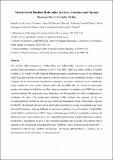Alkaline-earth rhodium hydroxides : synthesis, structures and thermal decomposition to complex oxides
Abstract
The rhodium (III) hydrogarnets Ca3Rh2(OH)12 and Sr3Rh2(OH)12 crystallise as polycrystalline powders under hydrothermal conditions at 200 °C from RhCl3·3H2O and either Ca(OH)2 or Sr(OH)2 in either 12 M NaOH or KOH. Rietveld refinements against synchrotron powder X-ray diffraction (XRD) data allow the first crystal structures of the two materials to be determined. If BaO2 is used as a reagent and the concentration of hydroxide increased to hydroflux conditions (excess NaOH) then single crystals of a new complex rhodium hydroxide, BaNaRh(OH)6, are formed in a phase-pure sample, with sodium included from the flux. Structure solution from single-crystal XRD data reveals isolated octahedral Rh centres that share hydroxides with 10-coordinate Ba and two independent 8-coordinate Na sites. 23Na magic-angle spinning NMR confirms the presence of the two crystallographically distinct Na sites and also verifies the diamagnetic nature of the sample, expected for Rh(III). The thermal behaviour of the hydroxides on heating in air was investigated using X-ray thermodiffractometry, showing different decomposition pathways for each material. Ca3Rh2(OH)12 yields CaRh2O4 and CaO above 650 °C, from which phase-pure CaRh2O4 is isolated by washing with dilute nitric acid, a material previously only reported by high-pressure or high-temperature synthesis. Sr3Rh2(OH)12 decomposes to give a less crystalline material with a powder XRD pattern that is matched to the 2H-layered hexagonal perovskite Sr6Rh5O15, which contains mixed-valent Rh3+/4+, confirmed by Rh K-edge XANES spectroscopy. On heating BaNaRh(OH)6 a complex set of decomposition events takes place via transient phases.
Citation
Cook , D S , Clarkson , G J , Dawson , D M , Ashbrook , S E , Fisher , J M , Thompsett , D , Pickup , D M , Chadwick , A V & Walton , R I 2018 , ' Alkaline-earth rhodium hydroxides : synthesis, structures and thermal decomposition to complex oxides ' , Inorganic Chemistry , vol. In press . https://doi.org/10.1021/acs.inorgchem.8b01797
Publication
Inorganic Chemistry
Status
Peer reviewed
ISSN
0020-1669Type
Journal article
Description
DSC thanks Johnson Matthey for the award of a CASE studentship. The I11 beamtime was obtained through the Diamond Light Source Block Allocation Group award “Oxford Solid State Chemistry BAG to probe composition-structure-property relationships in solids” (EE13284).Collections
Items in the St Andrews Research Repository are protected by copyright, with all rights reserved, unless otherwise indicated.

